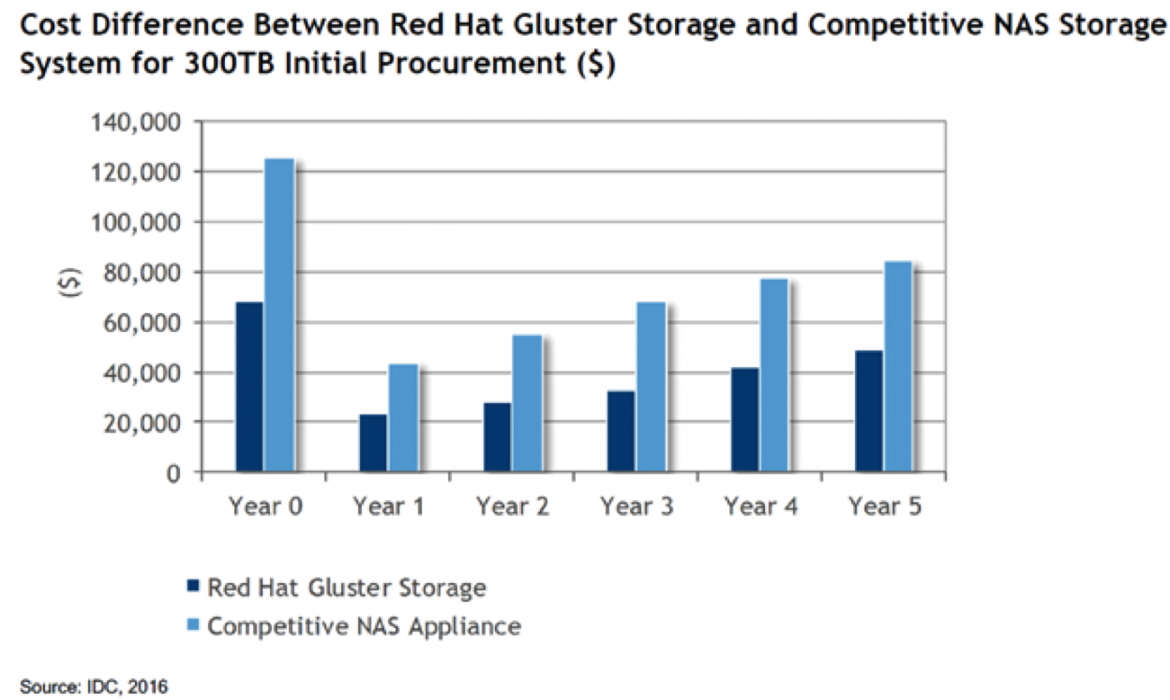Red Hat Storage received a resounding endorsement from IDC in the recently published analyst opinion whitepaper on the economics of software-defined storage. Over the past decade, one of the change drivers motivating companies to move off traditional storage appliances to software-defined storage has been rising costs, given the mounting pressure to retain and process more data than ever before.
In this paper, IDC concludes that “over a five-year period, procuring server hardware with internal disks and deploying a software-based storage solution such as Red Hat Gluster Storage and Red Hat Ceph Storage can save businesses over 39% and 53%, respectively, compared with a competitive NAS solution.”
But wait—There's more....
The savings numbers by themselves are compelling enough for most CIOs considering the transition from monolithic, proprietary storage appliances. However, there are a number of additional savings that can make the decision a no-brainer.
- Businesses can leverage the latest innovation in servers, spinning disks, memory, flash, external disk systems, and other components to continuously evolve their storage systems, rather than being tied to the plodding innovation cycle of their storage vendors. As hardware prices decline, companies can purchase hardware at lower prices over time rather than being forced to make a large investment at the outset.
- Customers can scale storage infrastructure built on practices and standards adopted by the largest cloud service providers, bringing greater efficiencies and helping to convert capital expenditure (CapEx) to operating expenditure (OpEx).
- Datacenters that have undergone recent hardware refreshes can reuse older servers and hardware as storage servers, thus reducing cost and improving utilization.
- Capacity planning is a breeze, because enterprises can purchase exactly how much they need for ready-to-go projects rather than over-provision to allow for future growth. With software-defined storage, expensive and cumbersome migrations are a thing of the past, because the hardware and software updates happen on an incremental and more manageable basis rather than discrete forklift upgrades.
"Open" is more than a modifier
One of the topics clearly outlined in the IDC paper is the preeminence of “open” and “open source” in almost every aspect of the datacenter. The open source experiment that started more than 20 years ago has now turned to the default option for many enterprises. In the words of IDC: “Today, Linux not only is used to run applications but also powers many hardware-based storage platforms—a fact that has not gone unnoticed by many.”
Storage built with open standards, using open source storage controller software, offers customers the best of both worlds—latest innovations driven by hundreds and thousands of practitioners across the world and unmatched cost efficiencies for enterprise-grade solutions on par with any incumbent storage technology.
Open source has cost implications beyond product and support. For instance, because Linux skills are ubiquitous in most datacenters, training to be a storage administrator for Red Hat Ceph and Gluster Storage is a much smaller skills investment compared to what’s required for a dedicated storage administrator to master a proprietary storage appliance.
"Software-defined" defined
Not surprisingly, many traditional storage appliance vendors have tried to rebrand themselves as "software defined" by adding superficial add-ons, but when you look under the covers, they leave much to be desired in terms of flexibility and choice.
The IDC paper cites a few building blocks essential to any software-defined solution that can serve as a litmus test for customers looking for a truly software-defined solution:
- Standalone or autonomous storage controller software for storage access services, data persistence, networking functions, and interconnects that make no assumptions of underlying hardware components or any underlying resilience or redundancy schemes like RAID
- A system that supports rolling hardware and software upgrades, as well as the ability to run mixed hardware configurations
- Platforms that do not contain proprietary hardware components like custom-designed ASICs, accelerator cards, chipsets, memory components, or CPUs
- A shared-nothing architecture in which data is shared and distributed (commonly found in scale-out environments) and that allows nodes to function independently, in contrast to scale-up systems with proprietary interconnects to share hardware resources
The breakdown
The IDC whitepaper compares the acquisition and maintenance cost of 300TB of Red Hat Gluster Storage and 500TB of Red Hat Ceph Storage (on Supermicro hardware) with competitive NAS storage system spanning 3- and 5-year horizons. The results speak for themselves.
It's more than just storage
While the IDC whitepaper focuses squarely on the economics of software-defined storage, the author is quick to point out that Red Hat Storage can bring added value to the organization through “storage and data management efficiency, increase in application performance, reduction in storage infrastructure costs, and increase in IT productivity.”
[embed]https://youtu.be/Eljuj5z9VmA[/embed]
You can dive into the IDC whitepaper and get started right away with your Red Hat Gluster Storage or Red Hat Ceph Storage test drive today.
저자 소개
채널별 검색
오토메이션
기술, 팀, 환경을 포괄하는 자동화 플랫폼에 대한 최신 정보
인공지능
고객이 어디서나 AI 워크로드를 실행할 수 있도록 지원하는 플랫폼 업데이트
클라우드 서비스
관리형 클라우드 서비스 포트폴리오에 대해 더 보기
보안
환경과 기술 전반에 걸쳐 리스크를 감소하는 방법에 대한 최신 정보
엣지 컴퓨팅
엣지에서의 운영을 단순화하는 플랫폼 업데이트
인프라
세계적으로 인정받은 기업용 Linux 플랫폼에 대한 최신 정보
애플리케이션
복잡한 애플리케이션에 대한 솔루션 더 보기
오리지널 쇼
엔터프라이즈 기술 분야의 제작자와 리더가 전하는 흥미로운 스토리
제품
- Red Hat Enterprise Linux
- Red Hat OpenShift Enterprise
- Red Hat Ansible Automation Platform
- 클라우드 서비스
- 모든 제품 보기
툴
체험, 구매 & 영업
커뮤니케이션
Red Hat 소개
Red Hat은 Linux, 클라우드, 컨테이너, 쿠버네티스 등을 포함한 글로벌 엔터프라이즈 오픈소스 솔루션 공급업체입니다. Red Hat은 코어 데이터센터에서 네트워크 엣지에 이르기까지 다양한 플랫폼과 환경에서 기업의 업무 편의성을 높여 주는 강화된 기능의 솔루션을 제공합니다.



